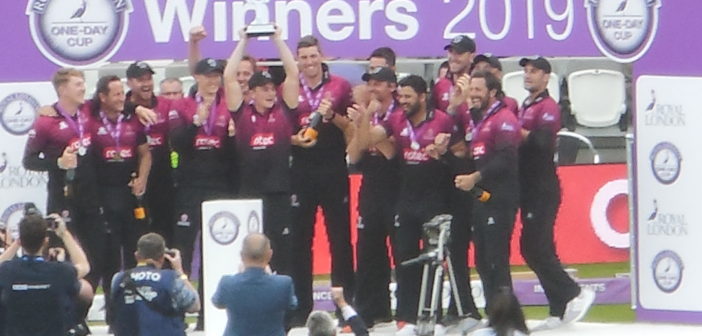Somerset won the Royal London One-Day Cup final after beating Hampshire 245-4-244-8, at Lords.
For the neutral, the 56th Lord’s final ended more with a whimper than a bang. It was a one-sided encounter in front of an attendance of 15,700 for a ground which holds 29,500.
I remember these occasions from my 1980s youth; they helped fire my love of cricket. There used to be two Lord’s finals a year, high spots of the cricketing summer, with several last-ball finishes, played by star players to packed stands and spectators overflowing on the grass around the boundaries.
Now there is one Lord’s final a year, squeezed into the calendar, played by those who have nowhere better to go.
When ECB central contracts came in, the assurances were that all players would be available for the county knockout matches. That promise has long since been forgotten. Both Hampshire’s best batsman and bowler in the competition this season – James Vince and Liam Dawson – were playing for England. Aiden Markram second in Hampshire’s batting averages and bowling economy rates was away with South Africa.
This left Hants underpowered and lacking all-rounders which evidently showed. Their long tail looked a weakness, but James Fuller and number 10 Mason Crane put on the highest and spriteliest partnership of the innings: 64 in 9.1 overs. This at least gave Hampshire a total to defend, but it never looked enough; not unless they took early wickets.
Fuller hit the only sixes of Hampshire’s innings, both coming in the final over. Somerset’s only six came in the third over, when Tom Banton hit Fidel Edwards over square leg. Edwards was Hampshire’s best bowler. Even at 37 years old, the former West Indian quick is still rapid, regularly clocking speeds in the high 80s, occasionally in the 90s.
One of the perceived traditions of those September Lord’s finals of yesteryear was that a good performance could earn a place on England’s winter tour. Twenty-year-old Tom Banton’s fine 69 off 67 balls will only enhance his growing reputation. Expect a winter tour for him, although probably with the Lions.
The coming and going of players makes a slight mockery of the integrity of the competition, as Yorkshire supporters will long be aware. Yorkshire – who did not make a Lord’s final in the white-ball era – regularly qualified for the knockout section only for England to scoop up half their team.
Their understudies were predictably outclassed in the knockout matches. Settled sides are often better sides – Somerset used 13 players in their 11 matches, with nine ever present. Next season the 50-over competition, the final of which will be at Trent Bridge for the next five years, will be concurrent with The Hundred.
This will further reduce the quality of player available but, in a weird way, will give the competition more integrity, as squads should at least remain the same throughout the whole competition.
But all that is for the future. The present – and past – is that Somerset won their first Lord’s Final since 2001, and only their eighth trophy in their history. It somehow seemed appropriate that Somerset, the dominant one-day team of youthful memory – Botham, Richards, Garner, Marks et al – won the final Lord’s final.
![Prost International [PINT]](https://prostinternational.com/wp-content/uploads/2021/08/PINTtFontLogoRoboto1536x78.jpg)



